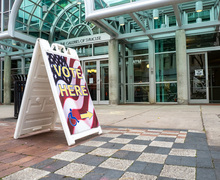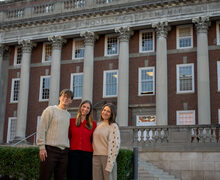Hotel Syracuse restoration and tours provide insight into city history
Aline Peres Martins | Contributing Photographer
Originally constructed in 1924, Hotel Syracuse holds historical and local significance -- many Syracuse residents have memories of the hotel.
The Beatles once talked of reuniting at none other than Hotel Syracuse.
John Lennon threw his 40th birthday party in the grand hotel, only two months and a day before his death in 1980.
George Harrison and Paul McCartney, the other two members of the Fab Four, declined to attend due to strained relationships after The Beatles’ breakup in 1970. However, former Beatle Ringo Starr, Lennon’s producer Phil Spektor and poet Allen Ginsberg went to the party.
Starting Oct. 10, the general public can tour a newly-restored incarnation of the historic Hotel Syracuse, now called Marriott Downtown Syracuse, and see the same sights Lennon and his entourage did.
Scott Peal, educational director at the Onondaga Historical Association, and other OHA staffers will conduct the tours. Tours will cover the public rooms of the hotel as well as the kitchen, ballrooms and presidential and bridal suites as they are available.
The tours will share stories like Lennon’s — or the time there was a literal elephant in one of the rooms during the 1930s.
A baby elephant rode the elevator up to the Grand Ballroom for a convention, and reportedly left a smelly present before it left.
Anecdotes will change from tour to tour depending on what rooms are available, Peal said. However, each tour guide is responsible for coming up with their own content, making each tour different.
No matter who’s leading the tour, visitors will travel through the hotel, which was built in 1924 and was considered the most splendid hotel in the city for many years. The hotel has hosted countless weddings in its ballrooms and housed generations of distinguished guests over the years including President Eisenhower, President Kennedy, Elvis Presley, Bob Hope and Charles Lindbergh.
But the hotel’s 90-odd years of history were on the line when it closed in 2004 and fell into disrepair.

Aline Peres Martins | Contributing Photographer
Ed Riley, the restoration project’s central authority, obtained the building in 2014. He saw the opportunity to re-establish Hotel Syracuse’s prominence and historic grandeur.
“It was getting to the point where if somebody didn’t step up or there wasn’t something planned for it … it would no longer be a candidate to be saved,” Riley said.
The Hotel Syracuse Restoration project has had a wide-ranging impact on the community, preserving years of history and art, revitalizing the downtown area and supporting local businesses.
Given reputation of the hotel, the project has seen a lot of popular approval.
“Almost anyone that’s lived in Syracuse for any amount of time has a memory of the hotel,” Riley said.
Paul McNeil, general manager of Marriot Downtown Syracuse, came to the hotel 14 months ago. He has been working with Marriott for a long time, and decided to take the general manager’s position to help lead the restoration efforts, a project he said is meaningful to him.
“I came in with a vision to transform this hotel into the iconic hotel it was years ago,” he said.
But such an extensive renovation project needs more than just a positive response. A project this grand needs money, and lots of it.
Financing the project was complex, Riley said — complete restoration of the hotel totaled to about $23 million. A significant portion of that money came in the for of government grants, including a sum of $15 million that has helped turn the hotel into a state-of-the-art convention center.
With funding to back up the popular support, construction began.
Riley and McNeil both said they are perhaps most proud of the huge role local business has played in the project, especially, McNeil said, in providing jobs to workers. Ninety percent of the labor was done by companies in the Syracuse area.
Stickley Furniture, an internationally-known, 116-year-old company located in Manlius pioneered the hotel’s craftsman architectural style. It supplied furnishings for the hotel when it first opened in 1924 and when it reopened this year.
Most of the public furniture was done by Harden Furniture, a company coming up on 172 years of operation this year. Harden is responsible for the tables and seating arrangements that now scatter the hotel lobby. In addition to supplying new pieces, Harden refurnished and reupholstered chairs to replicate what would have been in the lobby 90 years ago.
Even with the help of well-established furniture makers, the restoration would not have the museum-quality historical accuracy it now displays without the Onondaga Historical Association, known as OHA, McNeil said.
Gregg Tripoli, executive director of OHA, said the organization provided the original architectural plan for the Hotel Syracuse building. Throughout its lifetime, the floor plan changed so much that some spaces of the building were closed off for periods of time. Now the original floor plan of the hotel is back in effect.
OHA also wanted to be involved with the artistic aspects of the restoration, Tripoli said. OHA’s large art collection boasts gems by local artists as well as depictions of Syracuse’s history as a city. Together, OHA and the restoration project team conceived the idea to display different themes of art throughout the hotel.
The hallways on guest housing floors all feature photographs from the hotel’s history. But in addition to the building’s history, OHA compiled themed collections chronicling key facets of Syracuse’s history including the Erie Canal, salt production, the Finger Lakes and railroads.
One of the goals of the art project, Tripoli said, was to give hotel guests a peek into the city’s history and make them feel welcome during their visit.
“Instead of having just regular old cheesy hotel art that was there to match the drapes, we could have art that told a story behind it, that would help people feel at home,” he said.
But perhaps the grandest artistic feature of the hotel was already standing: the mural behind the check-in desk.
Carl Roters, a professor of fine arts at Syracuse from 1946 to 1964, completed the mural, a 20-scene progression in a modestly Cubist style. The mural was the winning design in a competition staged by the city, which asked artists to submit works commemorating 100 years of Syracuse history. But at one point in its history, the mural was covered by a wall of mirrors.
One of OHA’s greatest fears was that the adhesive used to hang the murals on the walls would damage the painting underneath, Tripoli said. Luckily, the art was not harmed. Marek Mularski, a Polish artist now living in central Massachusetts, restored the painting this year.
Visitors will have a chance to see the mural on OHA’s hour-and-a-half tour, but in the rest of the lobby, they will see the hanging grand chandeliers. Nine original fixtures hang around the vast lobby, fixtures that were even painted the color they were 92 years ago.
When the chandeliers were re-installed in the hotel and turned on for the first time, McNeil said he remembers pedestrians stopping in their tracks and staring up into the ballroom from the sidewalk below.
Said McNeil, “That’s when the heartbeat came back into the hotel.”
Published on October 5, 2016 at 9:56 pm
Contact: cmrussel@syr.edu | @caseymrussell





